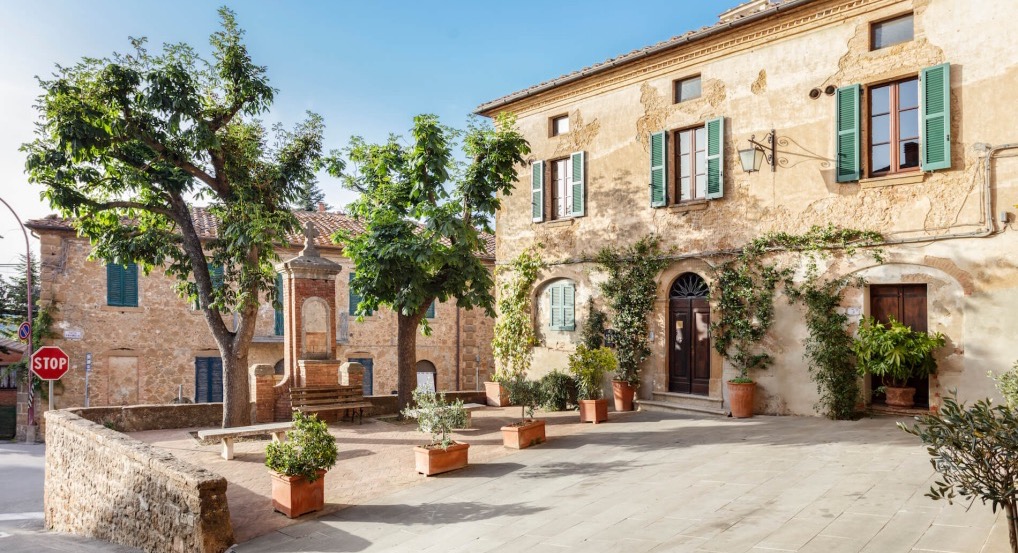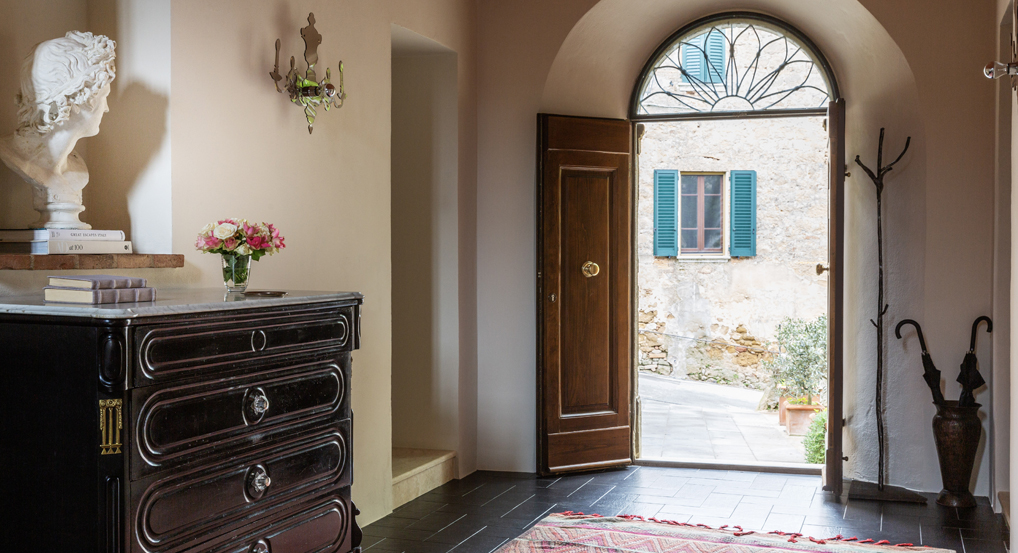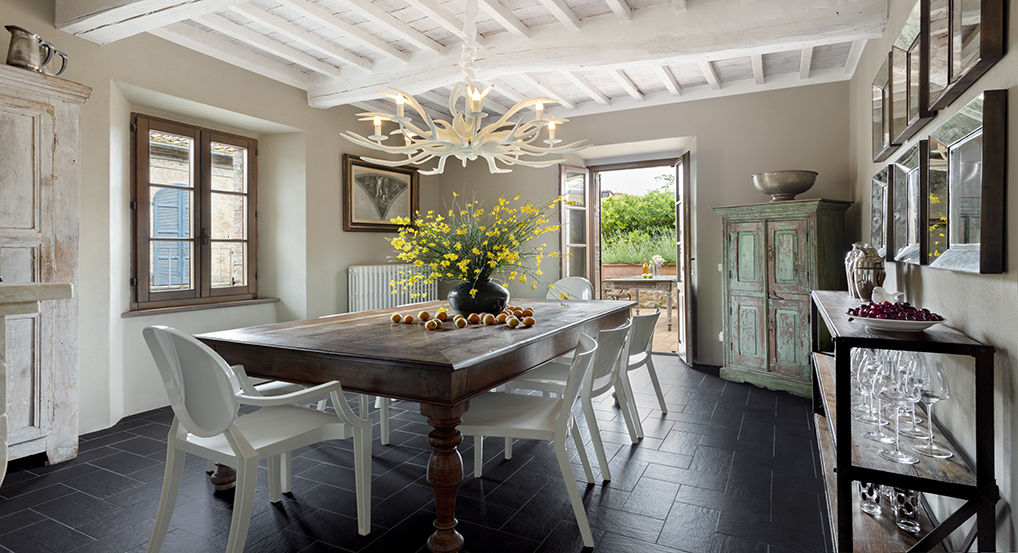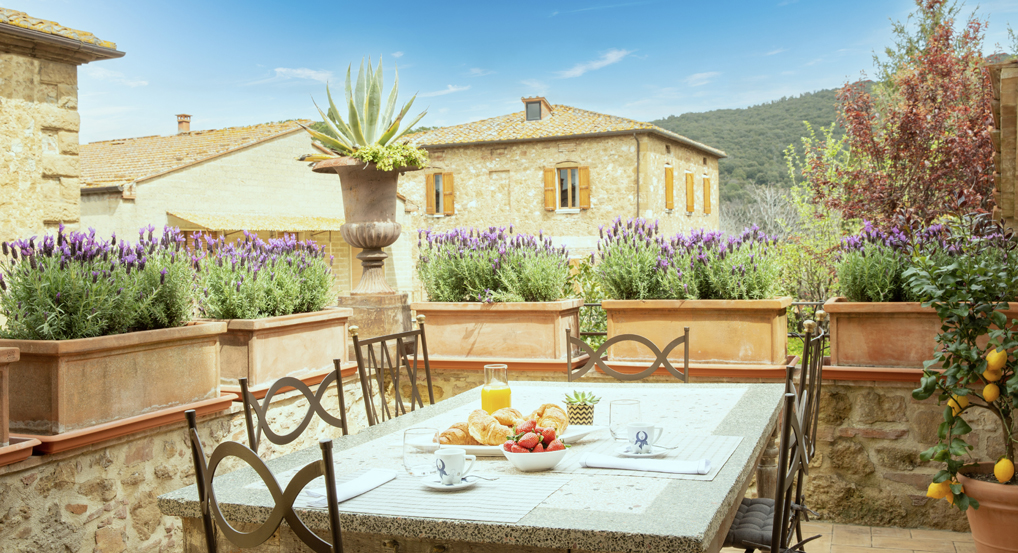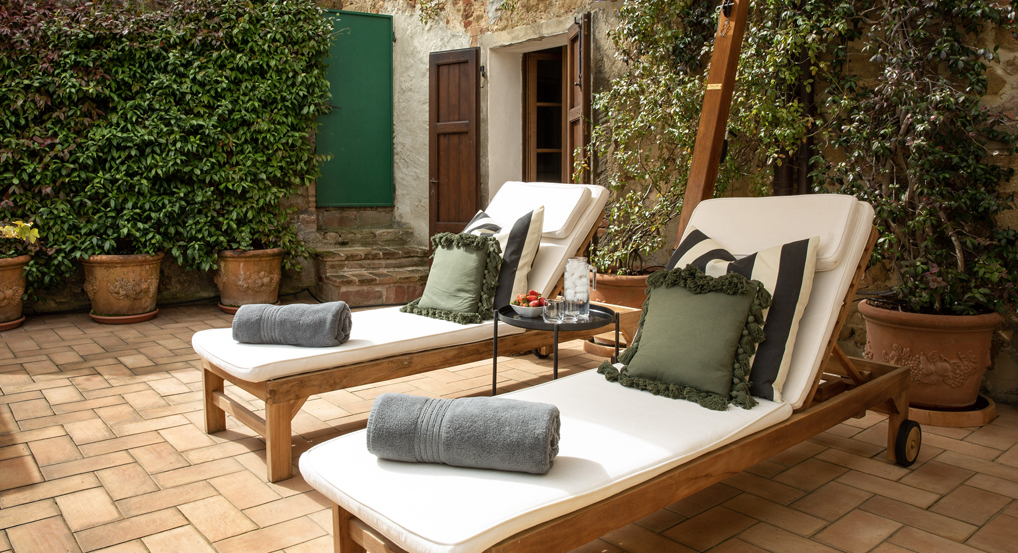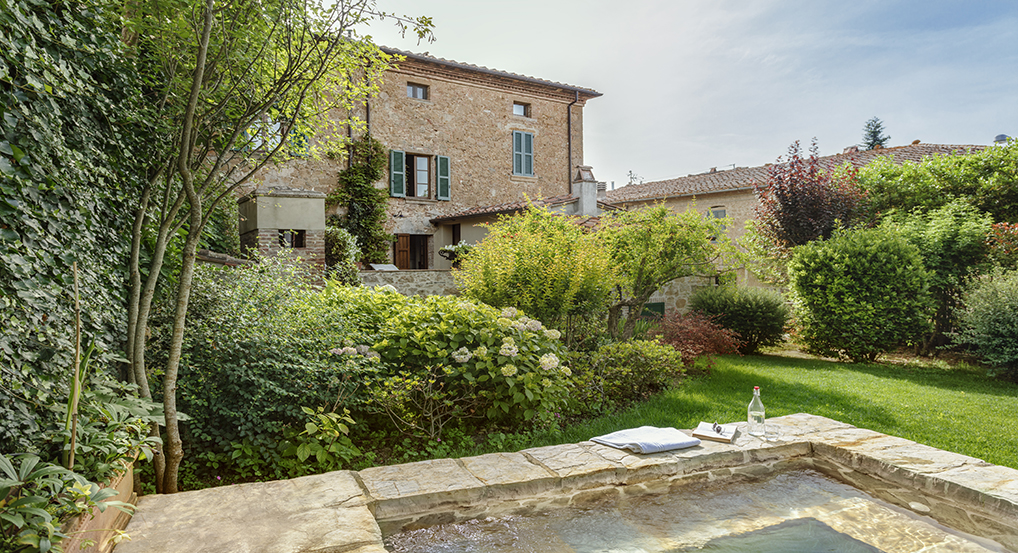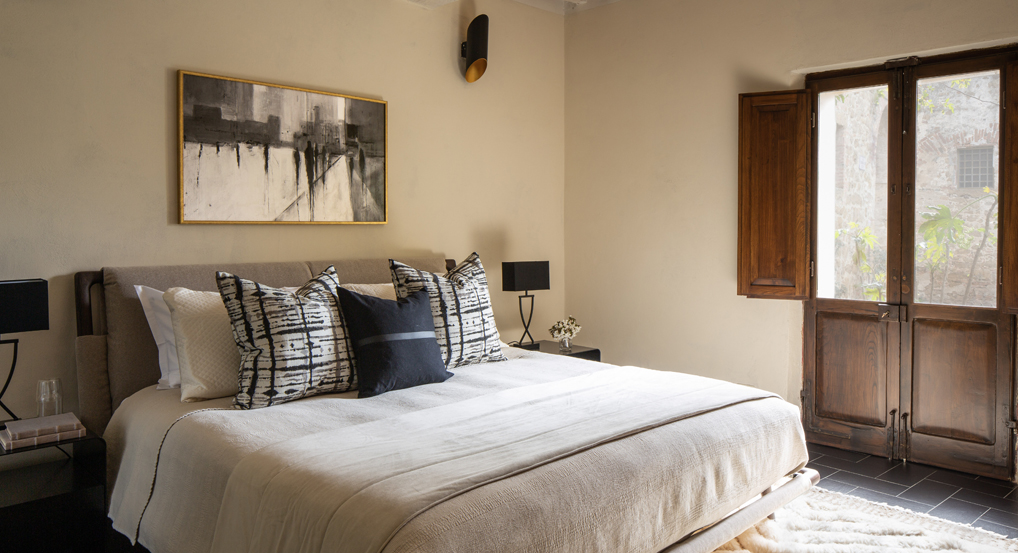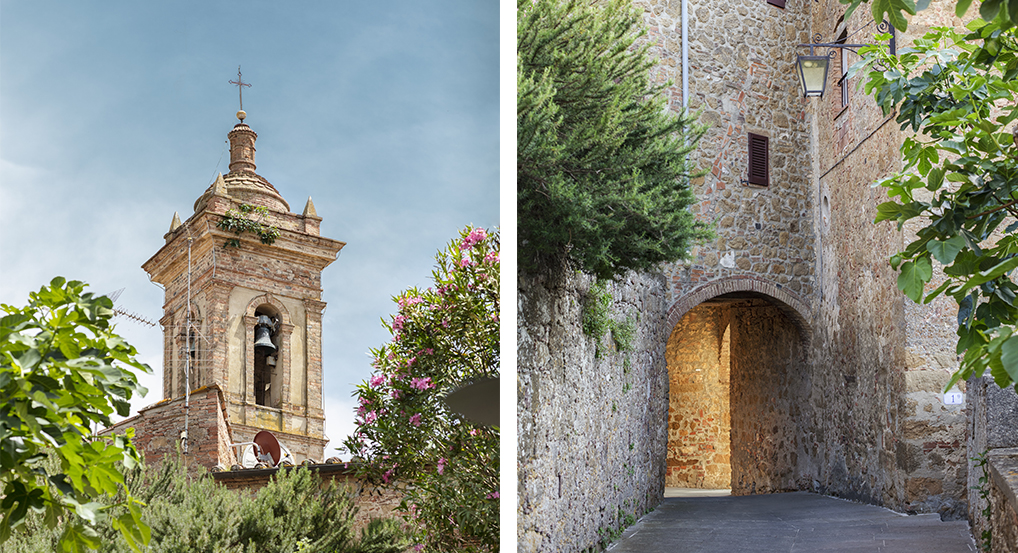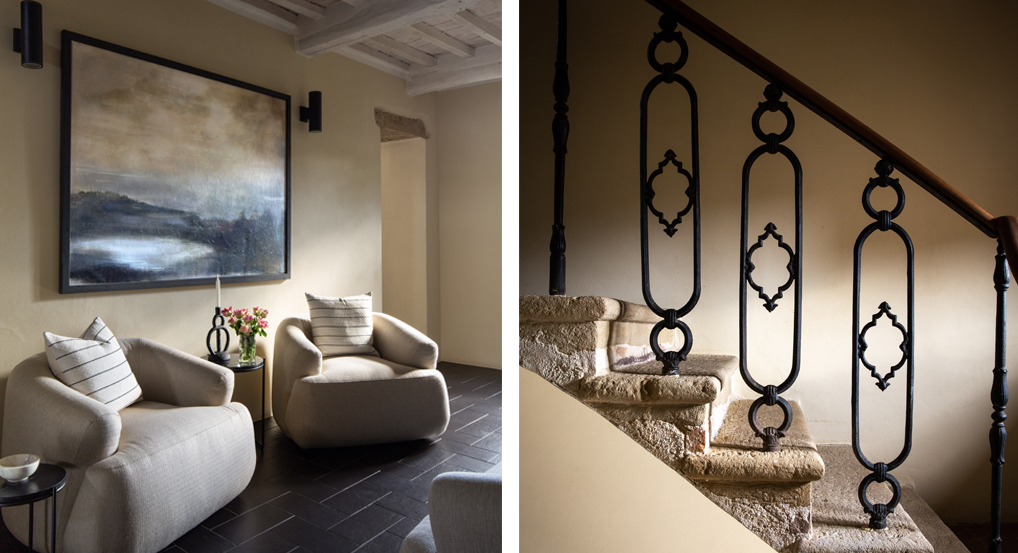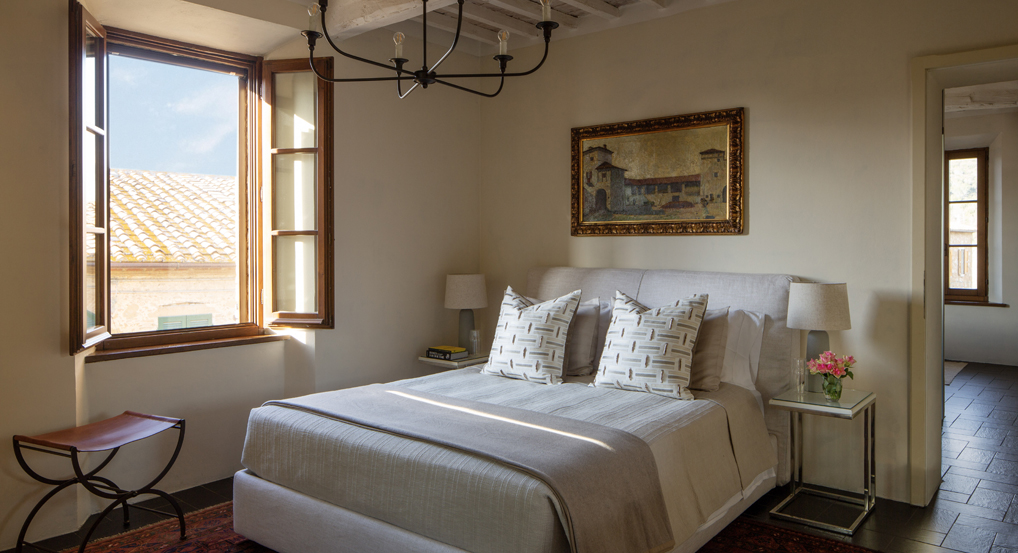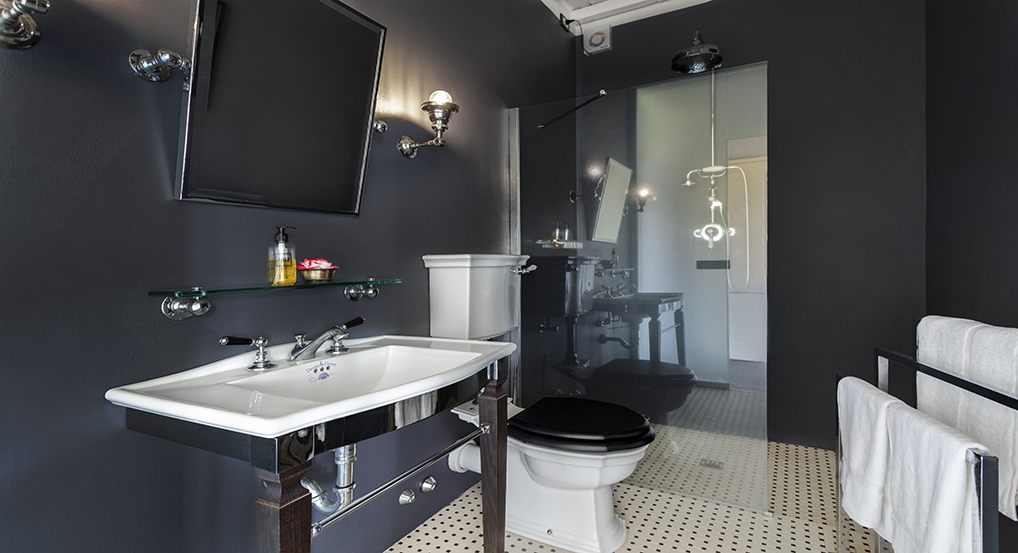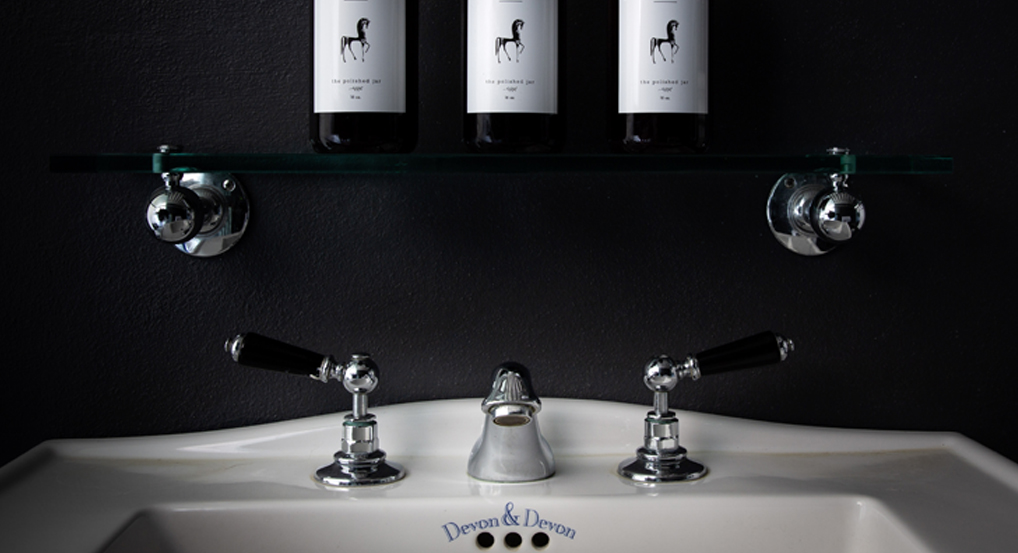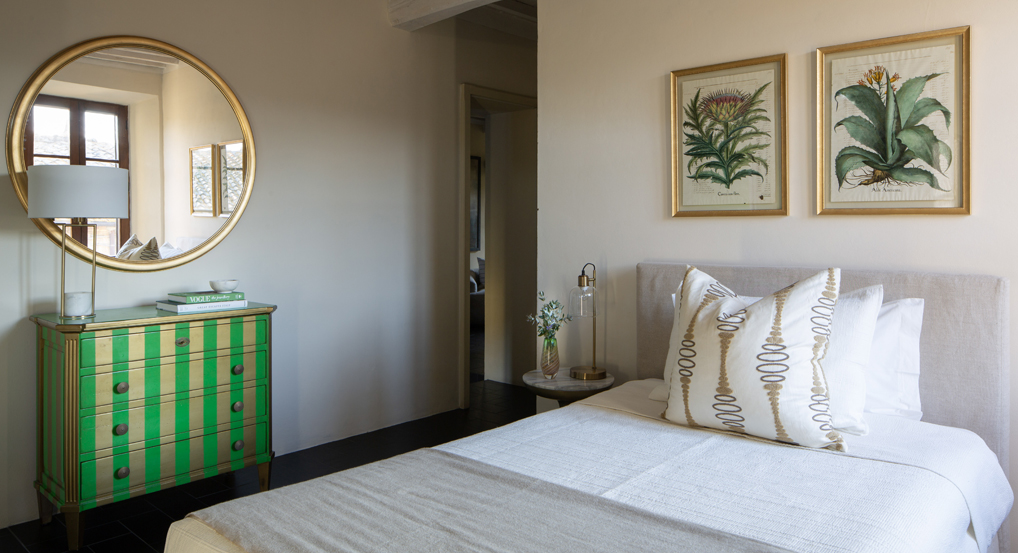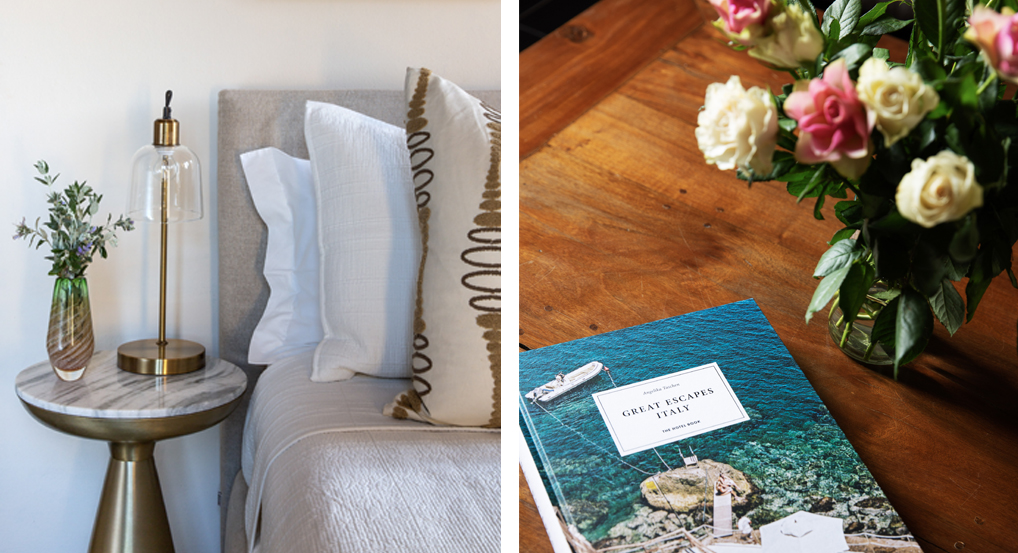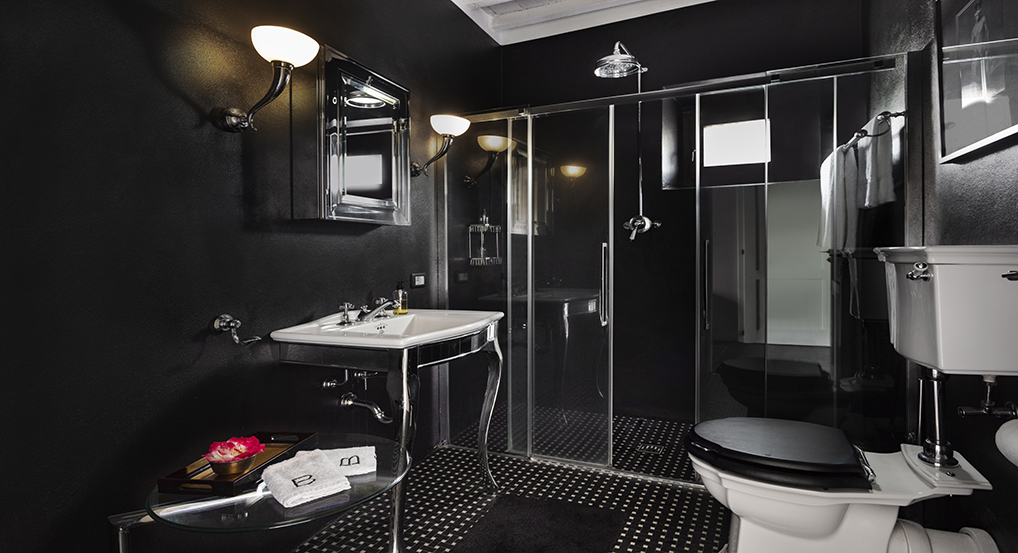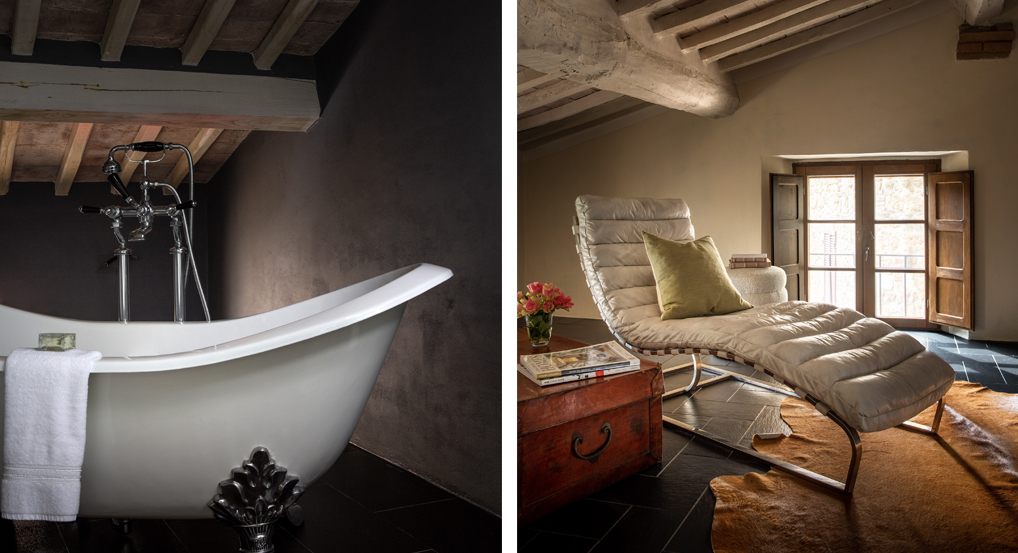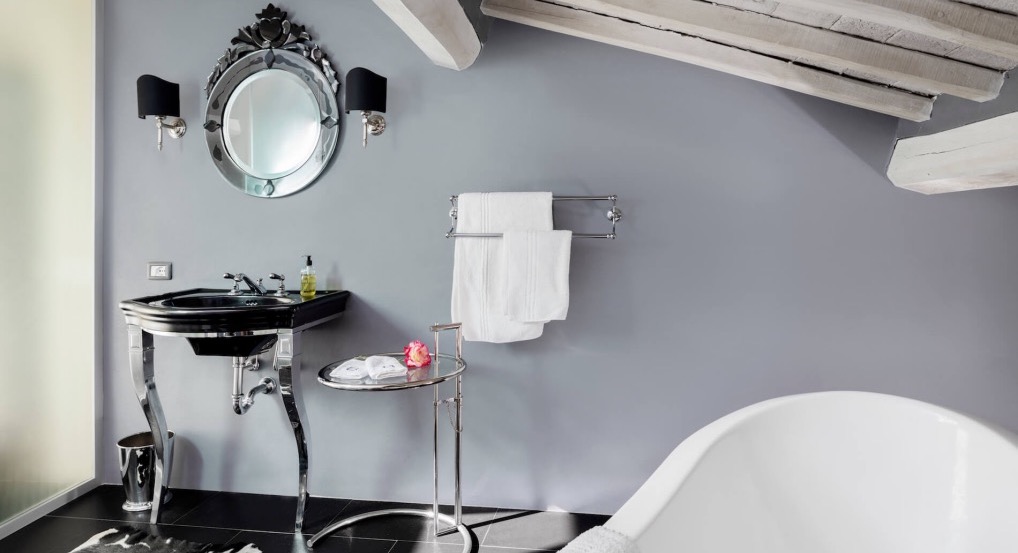Castelmuzio is named in documents in the 9th century of the Badia Amiatina di San Salvatore, under the name of Casale Mustia. In some texts in the Archives of the State of Siena dating back to 1213, appearing under the name of Castel Mozzo. The people that live there simply call it Castello.
Like the rest of the area, it belonged to the powerful Lords Cacciaconti della Scialenga, whose large domains included from the Fratta farm, not far from Sinalunga, reaching as far as the Castrum of Montepulciano.
In 1270, Castel Mozzo passed to the Republic of Siena and in 1354 the town became property of the Hospice of Santa Maria della Scala in Siena, whose emblem (affixed on a staircase) is still visible in the ornamental decorations put on the facades of some farms in the surrounding areas. For some time, it was ruled by the Salimbeni, then it was acquired by the Piccolomini who owned it until it was reconquered by Siena. With the defeat of the Republic of Siena, Castelmuzio was handed over by the Medici to the Grand Duchy of Tuscany.
The town of Castemuzio, is situated on the top of a hill of tuff overlooked by Mount Lecceto and facing the green valleys of Trove. It has the typical medieval structure of a fortified castle, walls and bastions. At the entrance of the town before a brief climb which leads to the entrance door, inserted in a war memorial, is the stone on which San Bernardino from Siena used to stand. The old door has the original “gangari” to open and close it and the spots from which the big stones were thrown to defend from attacks. The most interesting building resides in the central square: the tower which currently homes the Palazzo Fratini, recently restructured, which was once the court rooms; the Spedale di San Giovanni Battista which welcomed wayfarers and orphans offering them a place to stay and food as well as providing the dowry for girls without means; and the site of the Brotherhood of the SS. Trinita and of San Bernardino, which were attached to the pharmacy and a four bed hospice for pilgrims who walked to the nearby via Francigena.
• Museum of Sacred Art, full of fine pieces: a Madonna with saints thought to be by Pietro Francesco degli Orioli, a Madonna and Child from the studio of Duccio di Boninsegna, paintings from the studio of Beccafumi, Domenico Manetti and Sano di Pietro; a single terracotta Etruscan funerary urn from Abbadia Sicille and a fascinating collections of sacred decorations
• If you are an avid walker the Via Francigena is an ancient road and pilgrimage route running from the cathedral city of Canterbury in England, through France and Switzerland, to Rome, and then to Apulia, Italy, where there were ports of embarkation for the Holy Land. It was known in Italy as the “Via Francigena” (“the road that comes from France”). In medieval times it was an important road and pilgrimage route for those wishing to visit the Holy See and the tombs of the apostles Peter and Paul. Recommended routes for daily walking. We suggest routes 68-70 which are nearby easy to consult on en.wikipedia.org/wiki/ViaFrancigena
• Pienza is a tiny village in the beautiful Val d’Orcia we highly recommend you visit. The village is located about 20 kilometers east of Montalcino and a few kilometers to the west of Montepulciano amidst gentle undulating hills and wonderful natural landscapes. Pienza enjoys a strategic position standing high atop a hill, dominating all the Orcia Valley with extraordinary views. This charming village is widely known as the “ideal city of the Renaissance”.
• Montefollonico is a village in comune of Torrita di Siena, province of Siena. At the time of the 2001 census its population was 149. Montefollonico is about 60 km from Siena and 8 km from Torrita di Siena.
• Radicofani. On a hill at the southern border of the Val d’Orcia sits one of the most spectacular fortresses in Tuscany, for centuries one of the most important strongholds in Italy: Radicofani. The castle can be seen from dozens of miles away, and it appears to dominate the village, where it guarded the border between the Grand Duchy of Tuscany and the Papal States for hundreds of years. Built just after the year 1000, the fortress was renovated many times over the centuries, partially knocked down in the 1700s before being officially restored in the 1900s. From the balcony at the top of the tower, you can enjoy a vastly extensive view, from the entire Val d’Orcia to Monte Amiata, the Apennines and the Trasimeno and Bolsena lakes.
• The Abbey of Sant’Antimo, located 9km from Montalcino in Tuscany, is one of the most beautiful of all Romanesque churches in Italy. Local legend attributes its foundation to Charlemagne in the 8th century AD, a miracle that helped cure his army of a plague and a promise to build an abbey on the land where they were saved. Recorded history, however, has a different tale to tell and puts the foundation further back, to the Longobards and the Monastery of St. Savior. The site also is thought to have originally been the location of an ancient Roman villa. The existence of Sant’Antimo, itself, is recorded since at least the 9th century. By the 12th century, this abbey had become rich and the most powerful monastic landowner and foundation in Tuscany. Located along the Via Francigena, the pilgrims’ route to Rome, it benefited from the gifts of pilgrims and the faithful. It even owned large portions of land stretching from Lucca, in the north of Tuscany, to Orbetello, in the south. These times of great property did not last and by the 19th century it was in dire need of care and repair. When it came into the possession of the State, there was a long period of physical restoration that, ultimately, saved the whole building. Begun in 1872 and finished in 1895, it allowed for the current appearance of the abbey.
• Montepulciano is a medieval hilltop town in Tuscany, Italy. Surrounded by vineyards, it’s known for its vino nobile red wine. The Torre di Pulcinella is a clock tower topped by a figure of the Pulcinella, a commedia dell’arte character. On the Piazza Grande is the 14th-century Palazzo Comunale, with a tower offering views of the surrounding countryside.
• Montalcino. To the south of Siena is a classic fairytale hilltop town, set within a full circle of fortified walls and watched over by a mighty castle of medieval perfection. Montalcino, west of Pienza, is a beautiful village immersed in the breathtaking Val d’Orcia Natural Park, renowned all over the world for the production of its precious Brunello red wine. The town has scarcely changed in appearance since the 16th century. Once you get up to the town, a magnificent spectacle unfolds for your eyes: rolling sunny hills dotted with yellow and red flowers, ancient oak trees, picturesque olive groves, scenic country roads winding through perfect vineyards and isolated cypress trees atop hills. The town has been made incredibly rich and famous by its Brunello wine, one of the world’s best and most appreciated Italian wines. Montalcino was already well-known for its fine red wines during the 15th century. However, the precious formula of the fantastic Brunello was invented in 1888 by Ferruccio Biondi Santi, who first had the idea of leaving out the grapes used in the traditional Chianti recipe, such as Canaiolo and Colorino, and using only the Sangiovese variety.The town takes its name from a variety of oak tree that once covered the terrain. The very high site of the town provides views over the Asso, Ombrone and Arbia valleys of Tuscany, dotted with olive orchards, vineyards, fields and villages. The lower slopes of the Montalcino hill itself are dominated by vines and olive orchards.
• San Quirico. In the heart of the Val d’Orcia, nestled amidst hills of incomparable beauty, sits an ancient village that probably dates back to the Etruscan era, immersed in a landscape dotted with olive groves, vineyards and oak forests. The territory is one to be admired for its perfect balance honed over the years between the natural landscape and man-made marvels. San Quirico d’Orcia, with its splendid fortresses and medieval parish churches, is in this area so famous for its stunning landscapes – one of those places that must absolutely be visited if you’re in this enchanted territory. Among the must-see attractions are the parish church of San Quirico, a Romanesque building that preserves an altarpiece painted by Sano di Pietro, a 15th-century painter of the Sienese school, and, in the town’s central piazza, the Church of San Francesco, whose interior contains several Gothic elements. The center of the town is particularly picturesque thanks to the inviting paved streets and beautiful stone fountains. Something that stands out in the history and, partly, the appearance of the town is the fact that it sits along the Via Francigena, whose importance for San Quirico is evidenced by the presence of the Ospedale della Scala, where pilgrims were once offered refuge. Visitors won’t be disappointed should they stop by the ruins of the Cassero tower and the Horti Leonini, a typical 15th-centuy garden that can be accessed through an entrance between the wall and the piazza.
• Bagno Vignoni, the thermal station that has been known since Medieval times for its celebrated piazza d’acqua. Bagno Vignoni is a small spa of medieval origin, although it was already know in Roman times. Bagno Vignoni sits on a hill above the Val d’Orcia just south of San Quirico. The fascinating tiny village is clustered around a large pool closed on three sides by the town walls, with water that flows at 52°. The pool essentially fills the square, surrounded by a 1.5 metre-high wall on three sides. All around are buildings designed by Bernardo Rossellino in honor of Pope Pius II, while on the fourth side is the archway from which St. Catherine of Siena admired the view. This place also fascinated Lorenzo il Magnifico of the Medici family, who spent part of 1490 here. The old Francigena road passes near the village, and as the diary written in 1581 by Michel de Montagne confirms, piligrims and travelers heading toward Rome frequently stopped in Bagno Vignoni to find comfort in its hot springs. Nowadays Bagno Vignoni is well-known and appreciated the world over as an esteemed thermal locality situated in the heart of the Val d’Orcia.
• Siena is the capital of the province of Siena. The historic centre of Siena has been declared by UNESCO a World Heritage Site. It is one of the nation’s most visited tourist attractions, with over 163,000 international arrivals in 2008. Siena is likely Italy’s loveliest medieval city, and a trip worth making even if you are in Tuscany for just a few days. Siena’s heart is its central piazza known as Il Campo, known worldwide for the famous Palio run here, a horse race run around the piazza two times every summer. Mo- vie audiences worldwide can see Siena and the Palio in the James Bond movie, Quantum of Solace.
